Introduction
Craving authentic Louisiana flavor? This classic chicken and sausage jambalaya recipe delivers rich, spicy goodness in under an hour. Perfect for weeknight dinners or weekend gatherings.
Classic Chicken and Sausage Jambalaya
Ingredients
- 1 lb boneless, skinless chicken thighs
- 1 lb smoked sausage (like andouille), sliced
- 1 onion, chopped
- 2 green bell peppers, chopped
- 3 cloves garlic, minced
- 1 cup long-grain white rice
- 4 cups chicken broth
- 2 tbsp olive oil
- 1 tsp salt
- 1 tsp black pepper
- 1 tsp paprika
- 1 tsp cayenne pepper (optional)
Instructions
- Heat olive oil in a large skillet over medium heat. Brown chicken thighs until nearly cooked through. Remove and set aside.
- Add sausage to the skillet and brown. Remove and set aside.
- In the same pan, cook onion, bell peppers, and garlic until softened (5 minutes).
- Return chicken and sausage to the pan. Add rice, broth, salt, pepper, paprika, and cayenne (if using). Bring to a boil.
- Reduce heat to low, cover, and simmer 18-20 minutes until rice is tender and liquid is absorbed.
- Rest covered for 5 minutes before serving.
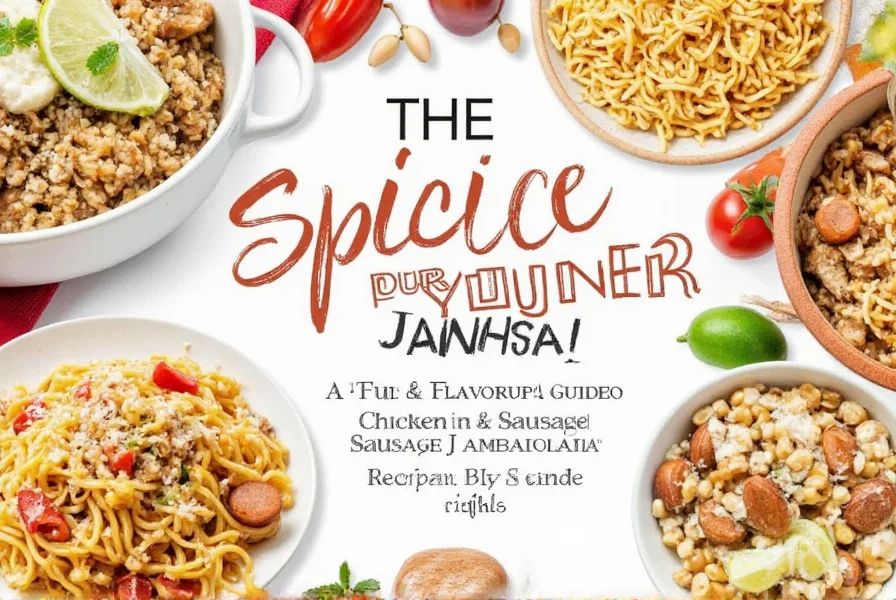
Vegan Chicken and Sausage Jambalaya
Ingredients
- 1 cup chickpeas, drained and rinsed
- 1 vegan sausage, sliced
- 1 onion, chopped
- 2 green bell peppers, chopped
- 3 cloves garlic, minced
- 1 cup long-grain white rice
- 4 cups vegetable broth
- 2 tbsp olive oil
- 1 tsp salt
- 1 tsp black pepper
- 1 tsp paprika
- 1 tsp cayenne pepper (optional)
Instructions
- Heat olive oil in a large skillet. Brown vegan sausage. Remove and set aside.
- Cook onion, bell peppers, and garlic until softened (5 minutes).
- Add chickpeas, rice, broth, salt, pepper, paprika, and cayenne. Bring to a boil.
- Reduce heat, cover, and simmer 18-20 minutes until rice is tender.
- Stir in vegan sausage. Rest covered for 5 minutes before serving.
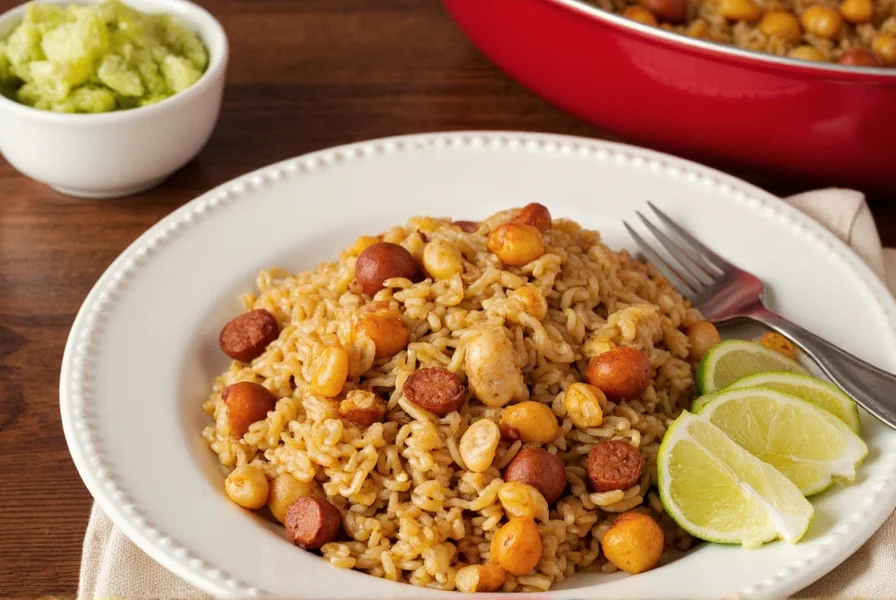
Practical Tips for Making Jambalaya
- Use fresh ingredients: Fresh garlic, onions, and tomatoes make a big difference in flavor.
- Don't rush the process: Letting the rice simmer gently ensures it absorbs all the flavors.
- Season as you go: Taste and adjust seasoning throughout the cooking process.
- Choose the right rice: Long-grain white rice is ideal for jambalaya, as it stays fluffy and doesn't get too sticky.
- Use a cast-iron skillet: This helps distribute heat evenly and enhances the flavor of the dish.
Spice Basics for Jambalaya
Jambalaya is all about balance. It's not just about heat—it's about layers of flavor that come together in perfect harmony. The spices used in jambalaya are usually referred to as the 'holy trinity' of Creole cuisine, which includes:
- Pepper (both black and cayenne)
- Garlic
- Onion
But that's just the beginning. Other essential spices include:
- Cumin
- Oregano
- Paprika
- Thyme
- Bay leaves
| Spice Level | Description | Best for |
|---|---|---|
| Mild | Limited use of hot spices, focusing on flavor over heat | Family dinners, first-time cooks |
| Medium | Balanced heat with a noticeable kick | Weekend meals, casual gatherings |
| Hot | High concentration of hot peppers or cayenne | Spice lovers, themed dinners |
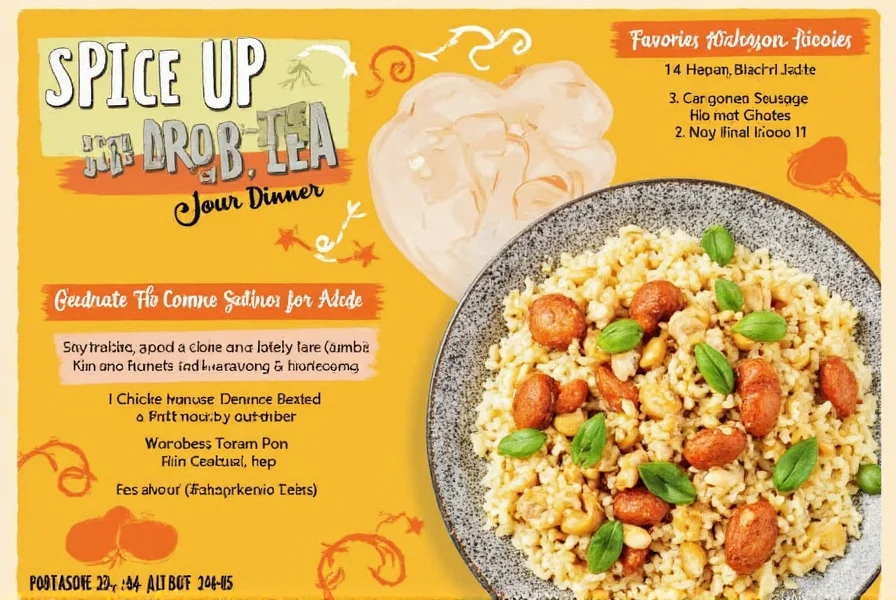
Buying Guide for Spices and Ingredients
Essential Spices for Jambalaya
- Cayenne Pepper: Adds heat. Look for high-quality, finely ground varieties. Best for those who enjoy a spicy kick.
- Paprika: Offers a sweet, smoky flavor. Smoked paprika is ideal for a deeper taste. Great for adding color and warmth.
- Cumin: Provides a warm, earthy note. Use it sparingly to avoid overpowering other flavors. Perfect for authentic Creole dishes.
- Oregano: Adds a robust, herbal aroma. Choose dried oregano for best results. Ideal for seasoning meats and vegetables.
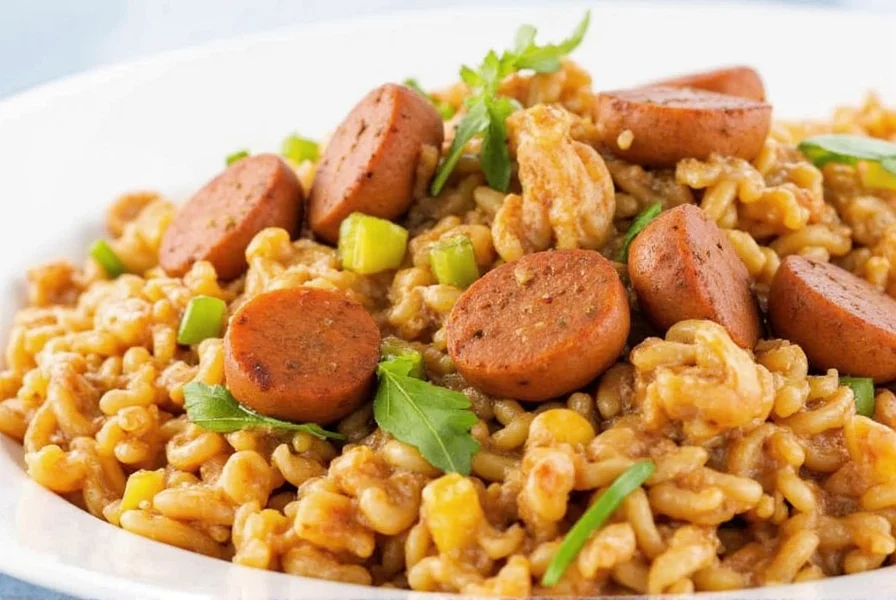
Choosing the Right Rice
- Long-Grain White Rice: Most commonly used in jambalaya. It stays fluffy and doesn't stick together.
- Brown Rice: Adds more fiber and a nuttier flavor. Good for a healthier option.
- Converted Rice: Pre-cooked and easier to handle. Ideal for busy cooks who want convenience without sacrificing quality.
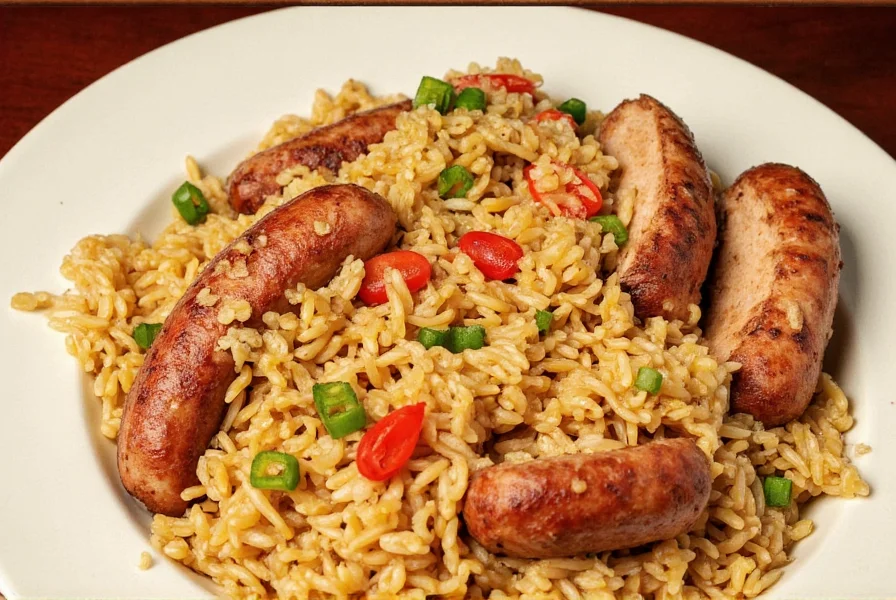
Meat and Sausage Options
- Chicken Thighs: Juicy and flavorful. Great for a moist, tender result.
- Andouille Sausage: A smoked, spicy sausage that adds depth and authenticity to the dish.
- Vegetarian Sausages: For a meat-free version, choose sausages made from soy or pea protein for a meat-like texture.
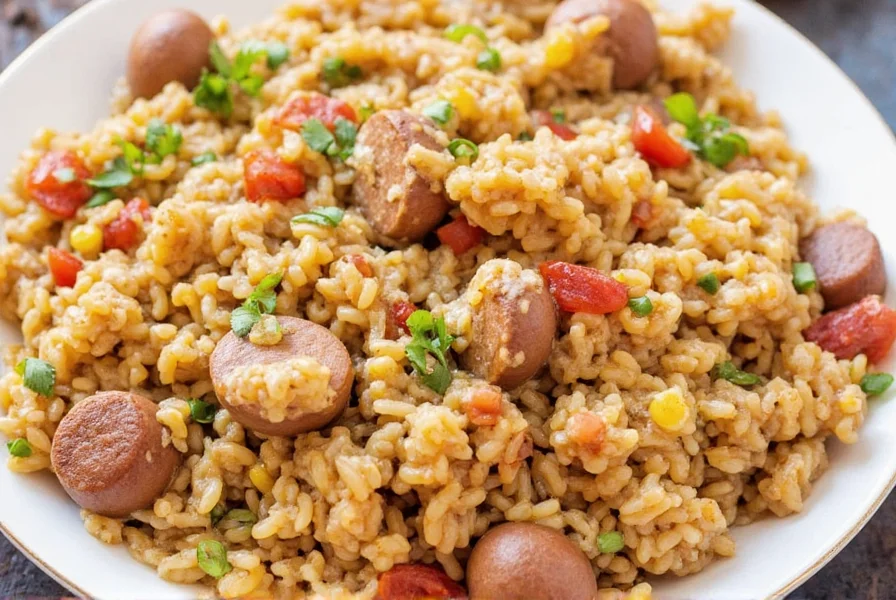
Frequently Asked Questions
How long does it take to make chicken and sausage jambalaya?
Traditional chicken and sausage jambalaya takes about 45-60 minutes to prepare and cook. This includes 15 minutes for prep work (chopping vegetables, slicing sausage, etc.) and 30-45 minutes for cooking. The actual simmering time for the rice is typically 18-20 minutes, but don't rush the process of building flavors with the "holy trinity" (onion, bell pepper, celery) first.
Can I make jambalaya with different meats?
Absolutely! While chicken and sausage are traditional, authentic jambalaya can include various proteins. Many recipes feature shrimp, crawfish, or even duck. Some versions use ham or bacon for additional flavor. The classic "brown jambalaya" often includes multiple meats, while "red jambalaya" typically features tomatoes. Just remember to add seafood later in the cooking process since it cooks much faster than chicken or sausage.
Why is my jambalaya too soggy or too dry?
The most common issues with jambalaya texture relate to rice-to-liquid ratio and cooking technique. For perfect texture:
- Use the correct rice-to-liquid ratio (typically 1 cup rice to 2 cups liquid)
- Don't stir after the initial mixing - this releases starch and makes rice sticky
- Let it rest covered for 5-10 minutes after cooking to allow steam to finish the process
- If too dry, add a splash of broth and fluff with fork
- If too wet, cook uncovered for 2-3 more minutes
Remember that jambalaya should have a slightly drier texture than regular rice dishes since it continues to absorb liquid as it sits.
What's the difference between jambalaya and paella?
While both are rice-based dishes with meats and vegetables, they have distinct differences:
- Origin: Jambalaya is from Louisiana (Creole/Cajun), while paella is Spanish
- Rice type: Jambalaya typically uses long-grain white rice, while paella uses short-grain bomba rice
- Technique: Paella develops a crispy bottom layer (socarrat), while jambalaya is stirred throughout
- Base: Jambalaya starts with the "holy trinity" (onion, bell pepper, celery), paella with sofrito (tomato, garlic, paprika)
- Liquid ratio: Paella uses more liquid relative to rice than jambalaya
Can I make jambalaya in a rice cooker or Instant Pot?
Yes, you can adapt jambalaya for modern appliances:
Rice cooker method: Brown meats and vegetables in a skillet first, then transfer everything to the rice cooker with proper liquid ratio. Use the standard rice setting.
Instant Pot method: Use the sauté function to brown ingredients, then pressure cook on high for 6 minutes with quick release. Let it rest 5 minutes before opening.
Note: Traditionalists argue that slow cooking on the stovetop develops better flavor, but these methods work well for convenience. The key is properly browning ingredients first to build flavor.
How should I store and reheat leftovers?
Jambalaya stores well and often tastes better the next day as flavors continue to meld. Here's how to handle leftovers:
- Refrigeration: Store in an airtight container for 3-4 days
- Freezing: Freezes well for up to 3 months (portion in freezer bags for easy storage)
- Reheating on stove: Add a splash of broth or water and heat gently over medium-low
- Reheating in microwave: Cover with damp paper towel to retain moisture
Avoid reheating more than once for best quality and food safety. The rice will continue to absorb liquid, so you'll likely need to add moisture when reheating.
Is traditional jambalaya supposed to have tomatoes?
This is a point of debate in Louisiana! There's a regional difference:
- Creole (New Orleans) jambalaya often includes tomatoes
- Cajun (southwest Louisiana) jambalaya typically does not include tomatoes
The version without tomatoes (sometimes called "brown jambalaya") lets the meat flavors shine through more directly. The tomato version ("red jambalaya") has a slightly sweeter, more acidic profile. Both are authentic - it largely depends on family tradition and regional preference. Our recipes above follow the more common Creole style with tomatoes.
Conclusion
Chicken and sausage jambalaya is more than just a meal—it's a celebration of culture, flavor, and spice. This easy recipe delivers authentic Louisiana taste with minimal effort. Whether you're making it for a family dinner or a special occasion, the key is balancing spices to your taste. Start cooking today and experience the magic of Creole cuisine!
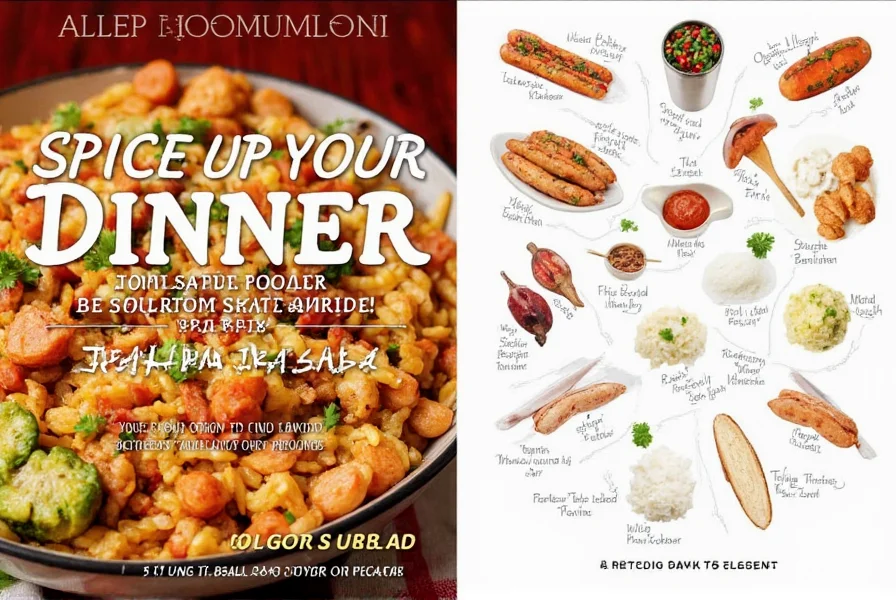

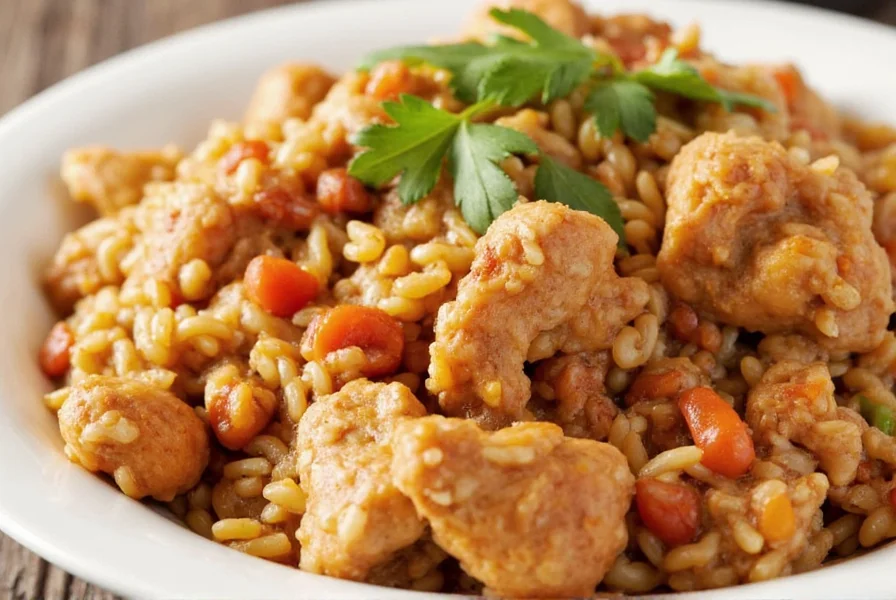









 浙公网安备
33010002000092号
浙公网安备
33010002000092号 浙B2-20120091-4
浙B2-20120091-4